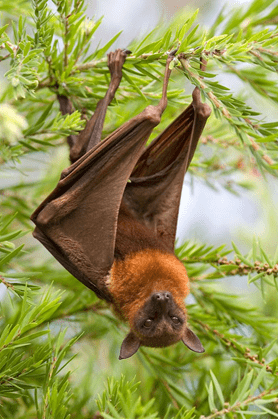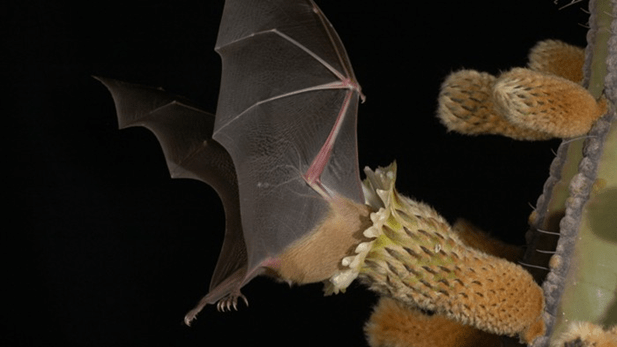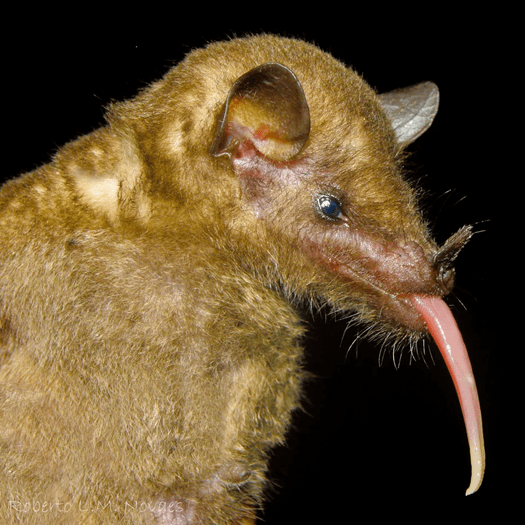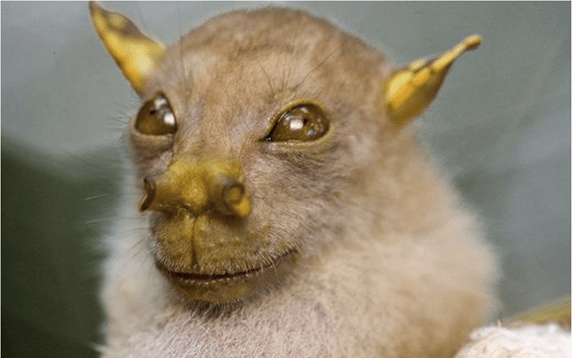Cerruti R2 Hooks$ and Anahí Espíndola*
$Associate Professor and Extension Specialist and *Assistant Professor, CMNS, Department of Entomology; twitter: @Analyssi
Note: This is the fourth article of our series on pollinators. Initial articles can be found within the Vegetable and Fruit Headlines News June and July special editions and Maryland Agronomy News Blog.
Introduction

Bats are the only mammals capable of sustained flight. They make up 20% of all known mammals and consist of at least 1,411 species. Bats live on nearly every corner of the globe and occupy multiple food niches. They play a vital role in insect control, seed dispersal and pollination. Although we tend to think of bats as insectivorous, many of them feed on fruits, and others on nectar and pollen. It is about these latter ones that we will discuss in this article. Most New World nectar bats are highly gregarious, living in colonies of a few hundred to tens of thousands of individuals. Their residences include caves, mines, hollow trees and abandoned buildings. Some Old World nectar bats live in groups within caves and others live solitary lives in trees or may just use a tree to chill for a while (Fig. 1). Nectar bats are long-lived (lifespans of up to 12 years or more) and as pollinators they are essential to the maintenance of ecosystem health, rainforests and global economies, as they ensure the reproduction of many plants. Indeed, bats contribute strongly to the pollination of plants, especially in the tropics, where they are considered pollinators of 1,000 plant species in at least 92 genera and 28 orders. Among these, over 530 species of flowering plants in at least 67 families rely on bats as their major or exclusive pollinators. Similar to moths, bats are nocturnal pollinators; and are just as important in pollinating crops as diurnal pollinators (birds, butterflies and bees). In fact, besides contributing to the reproduction of wild plants, bats also provide pollination services to plants of socio‐economic importance such as durian and mango. Bats play a vital role in maintaining healthy and productive habitats around the world.
Sources of Nutrients
Each bat species has food preferences, and different species may rely on fruits, flowers and/or insects for their survival. Some bats – many of them pollinators – may feed on flowers of economically important commercial crops, such as dates, mangoes and peaches. Other non-nectarivorous species consume massive quantities of insects every night. Insectivorous bats consume very large volumes of insects, including some economically damaging agricultural pests, such as codling moths in California walnut orchards and corn earworm moths that causes damage to cotton, soybeans and tomatoes, as well as June beetles, stink bugs and mosquitos. A single bat can eat hundreds of insects each night. A USGS study conducted in 2011 found that “Insect-eating bats provide pest-control services that save the U.S. agricultural industry over $3.7 billion per year.” A single colony of 150 big brown bats (Eptesicus fuscus) in Indiana was estimated to eat nearly 1.3 million insect pests annually. Thus, bats are arguably the primary predators of night flying insects. Pregnant or nursing mothers of some bat species feed more aggressively, consuming up to their body weight in insects every night. Notwithstanding, the pollinating role of nectar-feeding bats may be of greater importance than the contribution to insectivorous bats to insect reduction.
Bats as vital pollinators
Bats’ importance as pollinator vectors is felt globally. Nectar-feeding bats are found in every continent with tropical ecosystems. Similar to other pollinators, bat contribution to pollination is not equally distributed around the globe, with some regions displaying a higher diversity than others. To this point, most flower-visiting bats are found in Africa, Southeast Asia and the Pacific Islands. As pollinators, bats play a key role in contributing to the reproduction and fruit formation of an extremely large number of plant species. Many of these play key ecological roles and contribute to the subsistence of indigenous human communities around the world, while a couple are also economically important, such as the fruits of the columnar cactus, and the Agaves central to fiber and tequila production. Indeed, some products facilitated by bat pollination include fruits, fibers and timbers.
As indicated earlier, bat pollination occurs in the New and the Old World tropics. In the Old World tropics, several studies have examined the pollination effectiveness of bat pollinators. Flying fox bats (Fig. 1), for instance, are known to pollinate roughly 168 flower species in 100 genera and 41 families. Bats in Australia, pollinate the dry eucalyptus (Myrtaceae) forests, which provides timber and oils to consumers around the world. In the New World, pollinating bats are found in the family Phyllostomidae, and are known as leaf-nosed bats. Balsa trees, which produce the world’s lightest timber, is also bat pollinated. Beyond timber, over 300 species of fruit depend on bats for pollination. Their role as pollinators of tropical crops has been verified for species such as durian, bitter beans, and the fleshy fruits of mangoes, guavas and jackfruit, to name some. Further, some wild bananas are also almost exclusively pollinated by bats (Fig. 2). Indeed, some chiropterophilous (bat-pollinated) plants are so specialized that their reproductive success depends almost completely on bats.

In bat-pollinated crops, bats can have a direct impact on crop yield. For example, it was discovered that when the primary pollinators of pitayas – nectarivorous bats in the genus Leptonycteris – were excluded from flowers and flowers were pollinated by other taxa (i.e., diurnal birds and insects), pitaya yield among different cultivars decreased by 35% overall. Further, in the absence of bat pollination, fruit quality decreased markedly within all evaluated cultivars. More specifically, fruits were 46% lighter and 13% less sweet when pollinated by other taxa. Additionally, seed set was markedly lower in the absence of bat pollinators. All of this strongly indicates that the quality of the pollination service was suboptimal when pollination was provided by other organisms. As such, for some plants, birds, rodents or insect pollinators cannot be used as stand-ins for bats.
Bats, Agaves and Tequila. In the New World, nectarivorous bats such as the Mexican long-nosed bats have a very close relationship with Agaves. This species is one of only three nectar-feeding bats in the US, with a range that covers Mexico and the southern parts of Texas, California, New Mexico and Arizona. Mexican long-nose bats can fly extensive distances to gather nectar from specific plants and may visit up to 30 flowers each night to feed on nectar and transport pollen. Although we observe this species in the USA, they are migratory, spending their summers in Arizona and New Mexico, and migrating south into central and southern Mexico for the winter. Nectar is so important to them, that during migration, they follow a “nectar trail” so as to ensure that “fuel” (the sugar in nectars) is available to them along their travels. Interestingly, this species is one of the main pollinators of saguaro, the state cactus of Arizona.

Among the many Agaves, one that is at the base of a multimillion-dollar industry, is the tequila blue Agave, which is also bat-pollinated. As in many other pollination interactions, bats are important to the tequila industry (Fig. 3) and the tequila industry is important to bats, and this is so in a pretty interesting way. Tequila is produced using the sugars obtained from the leaves of certain Agaves, and tequila Agaves are pollinated specifically by an endangered species of bats, the lesser long-nose bat (Leptonycteris yerbabuenae; Fig. 4). In fact, the relationship between bats and tequila Agaves is so strong that these bat populations fluctuate in accordance with the success of Agave plants and Agave plants rely solely on bats to pollinate its flowers and reproduce. To boost production, tequila producers do not let their Agaves flower, this takes away a key food resource from bats as well as hinders sexual reproduction in Agaves. Over time, this practice led to two bad situations: bats started to decline and are now endangered of extinction, and the Agave plants lost genetic diversity and became susceptible to diseases that started decimating plantations (more than a third of the plants in some areas were killed-off because of disease!). Recent new management practices have however found a solution to both problems, which is currently supporting the survival of this industry in many regions of Mexico. In participating plantations, some Agaves are allowed to flower, which provides nectar to bats and contributes to their conservation, as well as increases the genetic diversity of Agave plants, protecting plantations from disease outbreaks. This has led to the production of what is today marketed under the label of “bat-friendly tequila”, which is now available across the USA.

Bat-pollination adaptations
Pollination by bats may be described as a four-step process: 1) bats fly to a plant to drink nectar from their flowers, 2) pollen sticks to the hairs on their body, 3) bats fly to another plant for more food, and 4) bat transfers the pollen from their body to the next plant. Though the process sounds simple, the relationship between bats and plants is one of give-and-take. In fact, over time, plants and their bat pollinators have shared a dependency on one another that is mutually beneficial. For instance, even though bats display many very impressive adaptations for nectar feeding, their contributions to cross-pollination are usually considered to fall in the category of “messy feeders”. In fact, when seeking the nectar, their faces and heads become covered with pollen, which is then transferred to another flower in their next visit. Further, because they are usually much larger than other pollinators, bat pollination tends to strongly damage the flowers, which has led to a number of counter-adaptations in bat pollinated plants.
Pollination interactions usually involve morphological and behavioral adaptations by plants and their pollinators; which is also true for bat-pollination. Starting on the bat side, bats that act as pollinators are adapted to obtain their energy from nectar, and also sometimes from pollen. To do this, they have evolved extremely well-adapted characteristics, such as long tongues (reaching sometimes up to 1.5x the bat’s body length!), “hairy” tongue tips that allow for fast and efficient nectar collection, and hairiness in regions that will eventually come in touch with the plant pollen. Relative to plants pollinated by bats, they have evolved special features to make their nectar and pollen attractive to these nocturnal visitors, and most importantly, easily accessible (Fig. 5). Plants that rely primarily on bat pollinators have thus evolved different morphologies, such as usually hanging ‘pincushion type’ flowers with multiple extended stamens, or ‘bell shaped’ flowers that are able to support the force applied by a bat flying directly into the flower. While pincushion flowers facilitate bat perching while feeding on nectar, bell-shaped flowers vary in size (1 to 3.5 inches) but are usually sturdy enough to support the bat visit. Importantly, while some large bat flowers can be exploited by unspecialized bats, only specialized bats can exploit nectar within small, bell shaped flowers. A common character of bat flowers is that they are white, pale- or dull-colored, and they are usually exposed well-away from the foliage (e.g., on stalks), which makes them stand out from the dark background at night. Bat flowers also tend to open after sunset, just as bats leave their day roosts to feed, and stay usually receptive throughout the night. They are naturally-large, wide-mouthed and sturdy to accommodate a bat’s face and resist its push without being (too) damaged. Thus, many bat-pollinated flowers are shaped like a vase, although some are flat and brushy so as to load a bat’s whiskers with pollen. In addition to their sight, bats use a keen sense of smell to find nectar-producing flowers. While many bat flowers contain a fermenting or fruit-like scent; some have evolved a musty or rotten odor, associated with sulphur-containing compounds. Because bats are not able to hover for long periods of time, nectar offered by bat-flowers is usually very dilute (not viscous) and copious, making it easy to collect and abundant. Further, to make visits to plants more attractive, bat-pollinated plants are suspected to synthesize specifically two bat essential amino acids, thus directly improving their health.

Extreme adaptations. Some bats have adaptations that allow them to reach the nectar at the bottom of very deep flowers. The tube-lipped nectar bat of Ecuador (Fig. 6) and the banana bat living on the Pacific coast of Mexico have extraordinarily long tongues to extract nectar from deep within the flower. The rare Anoura fistulata, a nectar-feeding bat from South America, has the longest tongue (proportionally) of all mammals. A. fistulata’s tongue is ~ 8.5 cm long, which is 150% of its body length. It is of no surprise that this species’ tongue is too long for its mouth. Thus, it is kept in their chest cavity between the heart and sternum. Further, there is a subfamily of leaf-nosed bats (Glossophaginae) which contain species that are highly specialized in procuring nectar. Similar to hummingbirds, they can hover in front of a flower while using their extremely long tongue to lap up even small amounts of nectar. These bats also have brushy hairs at the tip of their tongues, which increases the speed at which they can collect nectar during one flower visit, significantly increasing the energetic efficiency of their visits.

Also falling within the category of extreme cases of adaptation is how echolocation is used to facilitate pollination. It is well known that bats use echolocation when hunting insects. Echolocation is the location of objects by reflected sounds. Practically, bats that rely on echolocation use a sonar system, through which the echoes of sound waves allow them to determine the shapes of surrounding objects. Because the powerful echoes emit higher frequencies and vibrations, bats can use their sonar system to detect the presence of swift flying predators. Less known is bats’ ability to use this highly sophisticated system to find nectar-producing plants. This highly developed system enables some bats to maneuver in dense and clutter-rich vegetation. Recognition of motionless prey and specific plants can be difficult to locate in densely-rich vegetative habitats. Amazingly, some plants have evolved acoustic features in their flowers that acts as sound reflectors, amplifying the echo of the bat’s ultrasonic calls and assisting the bats in finding them even within the dense foliage in tropical rainforests. An exception to this is the case of the mega-bats (Megachiroptera; Fig. 7), who lack a sonar system. This group, relies instead on sight and sense of smell to locate food.

Differences with insect pollinators
In comparison to insect pollinators, bats are unique in that they are highly mobile, which makes them invaluable pollen dispersers. For example, the Phyllostomid family of bats can transport pollen up to 800m between trees in Puerto Rico, and leaf-nosed bats (Phyllostomus sp.) in Brazil can transport pollen up to 18 km between trees. Further, because they are covered in fur, bats are able to transport very large amounts of pollen. Related to this, many bats fly tens of kilometers from their day roosts to feeding areas each night, transferring pollen between plants that may be very distant from each other or that grow at very low densities. For this reason, bats are vitally important to maintaining gene flow and genetic diversity among (isolated) plant populations. As we saw earlier, this can have very real consequences on protecting crops from disease spreads and from monumental losses.
Besides pollination, bats provide other services that insect pollinators cannot provide, such as land restoration and plant dispersal. For example, through their droppings, fruit-eating bats (some nectar feeding bats may feed on fruits) spread seeds that are needed to restore cleared or damaged tropical rainforests. Some species of bats swallow large amounts of small seeds while consuming fruits (Fig. 8) which are passed out over clear-cut areas resulting in reforestation. Their travels are believed to continually introduce new plants to various habitats where some establish successfully, helping keep areas of growth highly diversified. Bats known as flying foxes are of particular importance in oceanic islands as they are often the only animals in these areas large enough to transport larger seeds. In some tropical areas of the world, over 90% of the regrowth of the rainforest is due to bat dispersed seeds. An estimated 186 plant products used by humans rely upon fruit bats for pollination and seed dispersal.

Finally bat droppings (also known as bat guano) serve as a natural fertilizer, contributing high levels of NPK to the soil in which they are integrated. It is common practice in regions where bats roost in colonies to collect their droppings and apply them to fields as fertilizers.
Bat conservation
Bat populations are severely threatened in many parts of the world; and it was suggested that 80% of bat species need research or conservation attention. This is important because as bat populations continue to decline, agriculture, the economies of tropical countries and access to food from many indigenous populations suffer. Two species of nectar-feeding bats, the lesser long-nosed bat and the Mexican long-tongued bat, which migrate from Mexico into Arizona, New Mexico and Texas every spring are currently listed as federally endangered species. The fact that bats contribute so much to pollination is partially why they are protected in many areas. For example, nectarivorous bats are essential to the functioning of agricultural and natural ecosystems in the tropics, yet they are declining due to hunting, and habitat alterations and loss.
Hunting is a major contributor to bat decline. Many species of the large-bodied flying foxes, including important pollinators and seed dispersers, are at considerable risk from hunting pressure, particularly on South Pacific islands and the Asian mainland. In eastern Australia, fruit farmers consider flying foxes to be ‘vermin’ and have eliminated many large roosts. In this respect, establishing and enforcing clear and well-informed educational program and policies can be a game changer for bat protection.
Alterations in habitats due to land-use can result in losses in roosting sites and floral resources, which are major contributors to bat pollination decline. Specifically, landscape fragmentation, habitat loss and degradation can disrupt the mutualistic interactions between bats and plants they pollinate and subsequently negatively impact the establishment and reproduction of full ecosystems. Further, bats of several migratory tree-dwelling species can be killed by wind turbines if they are not properly managed (blades stopped by about 90% of their speed during bat migration times has been recommended). As for all species, conservation success depends on improved conservation practices to ensure bats have access to healthy habitats. Some states with large bat populations are working to ensure that bats have a roosting site after a nighttime of feeding. Protecting feeding habitats and roost sites is critical to their recovery.
Summary
Though usually forgotten as pollinators, bats play a key role in the pollination of many wild plants and crops from tropical regions. Bats and the plants that they pollinate have been engaged in coevolutionary processes for millions of years, and some of their morphological, physiological, and behavioral adaptations are among the most impressive in the world of pollinators. In addition to contributing to plant reproduction, bats play a key role in maintaining plant genetic diversity, and connecting isolated plant populations and promoting their survival.
In relation to direct human benefits, bats contribute to the production of wholesome foods that are at the basis of the nutrition of many indigenous communities around the tropical world. From an industrial perspective, bats play an instrumental role in the agricultural industry. In 2011, it was estimated that the value of all bats to the agricultural industry is ~ $22.9 billion annually, which includes reduced costs of pesticides required to managed insects eaten by bats. From this respect, it is simple to understand why their conservation has been deemed in the best interest of national and international economies.
Financial support for the publication of this article is via USDA NIFA EIPM grant award numbers 2017-70006-27171.
